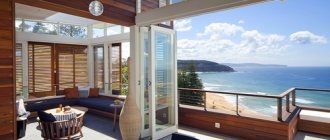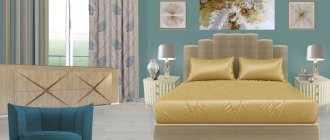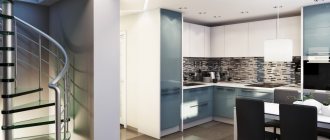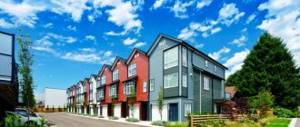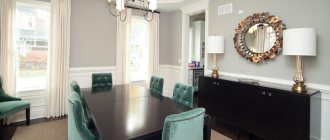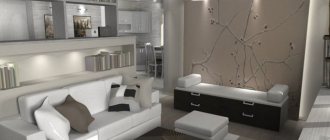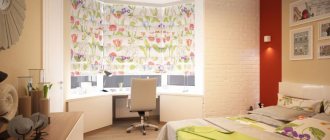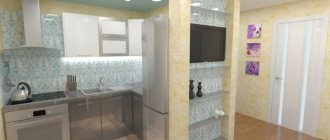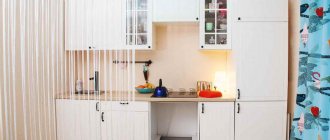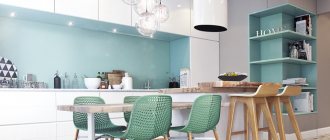Design features
Second-level lighting in the house helps solve the problem of high ceilings without using unnecessary details. Maximum natural light makes the overall atmosphere more cozy and comfortable.
This type of lighting is also a good source of light for the stairs on the second floor. The second light does an excellent job of naturally illuminating various types of attics and corridors.
In a multi-level apartment and in a cottage, second-row windows decorate not only the inside of the room, but also make the facade of the house more interesting and beautiful.
The implementation of the idea of second light should not come at the expense of the living room interior. So only some details should be selected for this lighting method, the rest should be consistent with the overall concept of the interior.
A one-story home can also be a place where secondary lighting is present. There are two ways to implement this design:
- The floor is lowered as much as possible;
- The ceiling covering is removed.
If an apartment or house has insufficient ceiling height, then finishing it to create a second light is an expensive pleasure. But this design technique will help create a truly exclusive interior.
Such tricks make the atmosphere unusual and unique, giving everything in the room a non-trivial look.
Advantages
The advantages of second light include the following:
- High compatibility with many interior styles;
- A special flair of lightness and luxury in the room;
- A large amount of natural light in the room;
- Highlighting both light and dark textures;
- Visual expansion of space;
- Lighting of two floors and stairs at once.
In addition to the obvious advantages, two-level light illuminates every corner of the room and highlights beautifully designed beams and beams on the walls. Helps to zone the space, placing light accents.
Second light in the house project
To plan a double-height room in a house, the total area of the building must be at least 120 square meters, and the height of the floors must be no more than 3 meters. A second light in a wooden house is considered a particularly popular option, because it gives the building even more ambiance. But a house with second-light technology will be a good choice only if it suits everyone living in it. It is worth considering that despite the aesthetic component, choosing a second light can also bring inconveniences, for which you should be prepared.
Projects of houses with second light
In house designs that provide for the presence of a second light, technical details must be taken into account:
- The structural design includes supports, consoles and load-bearing elements.
- The height of the walls in a double-height room must be at least 5 meters.
- In rooms on the second floor it is worth providing improved sound insulation.
- Glazing in houses should be carried out, taking into account the features of a double-height room.
Room design features
The options for architectural styles that you can turn to when decorating a double-height room with light are very wide. The second light can embody both classic style, minimalism, and modernism. It all depends on how to frame this decision. However, there are several elements necessary when designing a room with second light.
- Often in rooms with second light it is necessary to visually reduce the height of the walls so that they do not look empty and uncomfortable. To do this, use the technique of horizontal division.
- It is important to pay attention to the location of the house on the site. It is worth choosing it taking into account that the windows that provide second light in the common room offer the most pleasant view. It is advisable that the windows do not overlook neighboring houses, since providing curtains in such a design is not always convenient.
- Also, many designers provide outdoor lighting as an addition to what is already in the room.
Flaws
The disadvantages of the second light include such aspects as:
- High cost of the project;
- Impossibility of implementation in small spaces;
- Natural heat loss, which will require additional heating systems.
The solution to the heating problem here can be a fireplace. It will play the role of an additional source of heat, which is so lacking in living rooms with several levels of lighting.
Ventilation in a multi-level room is carried out according to an individual project, which also leads to an increase in its cost.
What styles does it suit?
The interior styles that the second light is suitable for can be almost any. But the second light level looks most advantageous in the Provence, country, loft, classic and modern styles.
Art Nouveau, Baroque, and palace classicism are also perfectly realized when using second light. Difficulties here can only arise with minimalism, since it does not use bulky furniture, which is an indispensable attribute of a room with high ceilings and huge windows.
To balance the second lighting with any style, you must adhere to the following rules:
- Select large interior details;
- Do not leave the center of the room empty;
- Use carpets and other objects that muffle the acoustics, or take advantage of the good sound and install a piano;
- Fill the wall space with shelves and decor to avoid the effect of empty and uninhabited space.
The second light during the day illuminates the room to the maximum, but in the evening the curtains are closed, so you should take care of artificial lighting of the huge room in advance.
What is the second light in the house
The second light in the house design means the absence of ceilings between floors. This architectural technique, due to high ceilings and natural light, fills the room on the ground floor with air, making it visually much more spacious and voluminous. Lighting in such houses is provided through windows of two or more floors. As a rule, rooms where the family spends more time together, that is, a living room, hall or dining room, are made double-height.
History of second light technology
The history of the technology for this type of lighting goes back to the times of ancient Rome, when the technology for producing glazed windows was first used. Then it was customary to glaze the ceiling of the front room to make it lighter and more spacious visually.
Later, in the Middle Ages, a fashion for stained glass windows arose. They filled window openings in cathedrals, palaces and castles, thus also creating an additional source of lighting. Stained glass windows were often located not on two, but on three or even more floors.
During the heyday of Gothic culture, the technology of using second light gained the greatest popularity. Then columns began to be used, which made it possible to erect buildings with high ceilings. Elongated windows were located along the perimeter of the walls, and there were stained glass windows in the window and interwindow spaces. In Gothic cathedrals, stained glass also conveyed a certain message, depicting religious or everyday scenes, and decorated the building outside and inside.
Today this architectural solution is common in the construction of country houses and two-level apartments. In the modernized version, the second light in the house design helps to expand the room, add volume, making the family relaxation space cozy and bright.
Distinctive features of the second light
When choosing a house project with second light, you should take into account its features. By combining several floors into one, you lose room that could be located upstairs. Therefore, double-height projects are better suited for buildings with a large area.
- Double-height rooms have high ceilings, which means they require additional heating.
- Also, the presence of high ceilings requires you to pay special attention to the ventilation of the room so that warm air does not accumulate at the top.
- Large windows will enhance the feeling of natural light.
- In such projects, the remaining rooms on the first floor are located around the living room (dining room). This eliminates the need for a corridor. The use of second-light technology is popular in the construction of two-story cottages, but this option is also suitable for one-story houses with an attic.
Space layout
When planning a house with a double-height room, it is worth considering certain details.
Most often, a room that will become double-height is first selected, and only after that the rest of the space is formed around it. On the top floor there are also bedrooms, which should be arranged as far as possible from the second light. This will minimize noise spilling into the living room. The room itself should be large so that it is aesthetically pleasing and convenient for the owners.
Pros and cons of second light
Like any architectural solution, second light has positive and negative sides.
Pros:
- Thanks to the high ceilings, the double-height space looks visually more spacious.
- The absence of unnecessary partitions helps to zone the space in an original way.
- The presence of natural and artificial lighting fills the room with light.
- The room looks aesthetically pleasing due to high ceilings and a large number of windows.
Minuses:
- The second light in the house takes up useful space. The second floor room where it will be located could accommodate a separate living room.
- Since a double-height room becomes more spacious, higher costs for thermal insulation are required.
- Sounds and smells will easily spread throughout the house.
- Maintenance of such a house is considered expensive.
Living room interior with second light
Living rooms with a second level of light were previously used in palaces and mansions. This arrangement of windows is related to European architecture of the 17th century.
The prestige of a double-height room increases significantly if it is decorated according to all the rules. Let's look at these rules using a table:
| Interior idea | Implementation |
| Gothic chandelier | The most simple design, large size, minimum of small details. |
| Panels and paintings | They are located at the level of the second and first windows; two-tier compositions are welcome. |
| Sofa | The largest sofa you can find or a medium sofa and two massive armchairs. |
| Bookcases | The highest possible structures, preferably from floor to ceiling. |
| Lighting | Wall sconces, floor lamps, ball chandeliers in one row from the center to the edges of the room. |
This arrangement of significant interior details will help achieve maximum harmony of space. The rest of the interior elements can look the way the home owner wishes and are arranged in accordance with the chosen style direction.
A living room interior with a second light can be made in both warm and cold colors. In addition, with such windows it is possible to use black on the walls and ceiling. Any dark colors with two-level lighting will look luxurious. The light shine of marble, Greek columns, noble wood and candelabra are the constant companions of the second light in the interior.
Correct lighting
Proper artificial lighting of a two-level room will reveal the design of the room in the most favorable light. But how to create such a lighting system so that it only emphasizes the advantages of a large hall?
Spot lighting is appropriate here as a means of highlighting the multi-level nature of the area. For example, it is used on stairs or in niches.
Wall lamps in this type of room, where there are additional windows, are best used in groups. It is permissible to illuminate the TV and paintings using LED strip. Floor lamps installed in the middle along with a sofa and coffee table are also good in this interior.
The main rule of artificial lighting in the second light is the use of wall sconces and similar accessories. Without wall light, at night the room will be illuminated only in the center, and its corners will be buried in shadows and twilight.
The highlight of the artificial illumination of the second light is contained in the chandelier under the ceiling. After all, with high ceilings, this detail is always paid attention to. Therefore, the chandelier must fully reflect the style of the interior concept.
Using curtains
Houses with a second light require a special approach to design. One of the important details in the interior here are curtains. With their help, the interior can be further emphasized and, in addition, protected from bright sunlight. At the same time, curtains can spoil the overall appearance, and the original idea will become tasteless rather than luxurious. That is why it is necessary to take into account certain criteria:
- Determine the function of curtains - decorative or protective.
- Consider the purpose of the room, its location to the light.
- Solve the issue of centralization: will the windows be the main attractive accent or part of the overall interior.
For the living room, the best solution would be to match the same style. Therefore, you can choose classic multi-layer curtains with lambrequins, tulle, tiebacks, loose-fitting curtains with eyelets, Japanese panels - the main thing is your imagination.
If you need to expand the room, then horizontal stripes will help you visually accomplish this task. On the contrary, a vertical print on the curtains will further emphasize the height, especially if curtains are used, the cornice of which is located under the ceiling.
Regarding the color scheme, it is worth noting that light colors add even more light. But if the windows face south, then even cold shades and dark colors will not spoil the atmosphere. It must be remembered that on bright or colorful walls, curtains should be plain, in a calm color scheme. Silk or synthetic curtains look great on matte light wallpaper.
Fireplace placement
A fireplace in a room is of great importance. It is a decoration and an additional source of heat. A seating area is usually set up in front of the fireplace. If the room is too large and its center is far from the walls where the fireplace can be placed, then you can use an imitation fireplace. For example, a glass fireplace that runs on special fuel or gas is better suited here than other options.
Where possible, the fireplace is placed between the central windows or to the side of them. This position helps combat heat loss and also does not disturb the overall harmony of the interior.
Sometimes a fireplace can be used for zoning. Then its pipe runs through the center of the room, and behind it there is a special stylized wall.
What curtains are needed?
Curtains for two-level windows may be absent altogether, or they may have a decorative function. In the hall, where the second light is located, the windows on the upper level are usually not curtained. They are located quite high, and in the evening their viewing angle is limited.
The lower tier of windows is decorated with thick curtains, curtains, and long multi-layered organza. Simple tulle will also fit harmoniously into the interior if it is embodied in light and warm colors.
When the lower and upper windows are located close to each other, they can be combined into a single ensemble with curtains with an automatic sliding system. Since it is problematic to curtain these curtains manually.
For inclined windows with a second light zone, it is possible to select decorative blinds. This technique is used in rooms where the second level is accessible by stairs.
Any designer knows that a wooden country house is the best platform for implementing a second level of light. After all, this effect can be played out very well.
Layout of various types of houses
The second light makes the building much lighter and more spacious. This solution makes the house as comfortable, aesthetically pleasing, multifunctional as possible, and most importantly, preserves natural lighting. However, to achieve such results, you will need to spend time planning the building, correctly positioning all the elements, choosing the right details and color palette to create an original design. Let's look at some of the nuances in the design of various types of houses with second light.
Useful: Do-it-yourself heated floor: water and electric
Brick house
The construction of a brick building especially requires proper planning. First of all, you need to take into account the length and location of communications:
- On different floors, bathrooms and bathrooms should be located one above the other
- On the same floor, the kitchen and bathroom should be adjacent to each other.
It is necessary to correctly calculate the number of bedrooms so that there are enough for all family members. You also need guest rooms, a hall, perhaps an office, a library.
It is not recommended to install walls and doors in public spaces in a brick building. Houses with a second light require space, so if zoning is necessary, it is better to do this using color and stylistic solutions, upholstered furniture, a fireplace and other solutions. You can save useful space by eliminating corridors.
Wooden house
For wooden houses, the area of the building is very important. A small building will only ruin the idea, so it should be large and spacious. Each room should be filled with air and well lit.
You need to understand that wooden houses are not practical building options. Their main emphasis is on beautiful design, which also needs to be approached with extreme care. To eliminate the feeling of emptiness, it is recommended to fill the room, for example, with living tall plants. Another option is stained glass.
Attention here should be paid not so much to the layout as to the heating in the premises. First of all, you need to carefully insulate the windows themselves. Installing heaters is impractical, since heat tends to rise upward, leaving cold air below. One of the best options is to install heated floors. The second solution would be to install light heaters, which will heat up surrounding objects.
Useful: How to build a reliable and inexpensive frame house for a summer residence
Frame house
Frame buildings have a very expressive external appeal, ready for extraordinary solutions and uniqueness. The natural illumination of the second light in them emphasizes the luxury of the house, thanks to the possibility of installing light-transmitting stained glass windows.
The layout of a building with a second light requires a carefully thought-out composition and arrangement of rooms. The central element of a frame house is the staircase. It can perfectly decorate a room, for example, if it is made of tempered glass. It’s also worth doing some decorating. Decor items can be exotic palm trees or conifers, beautiful luxurious curtains.
